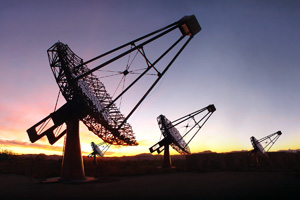New detector will improve method for gathering data on cosmic rays
By Steve KoppesNews Office
| |
Faint, fleeting blue flashes of radiation emitted by particles that travel faster than the speed of light through the atmosphere may help scientists solve one of the oldest mysteries in astrophysics.
For nearly a century, scientists have wondered about the origin of cosmic rays—subatomic particles of matter that stream in from outer space. “Where exactly, we don’t know,” said Scott Wakely, Assistant Professor in Physics and the College. “They’re raining down on the atmosphere of the Earth, thousands of particles per second per square meter.”
Recent results from the Pierre Auger Cosmic Ray Observatory suggest that the highest-energy cosmic rays may come from the centers of active galaxies. But the vast majority of the cosmic rays seen from Earth originate from unknown sources in the Milky Way galaxy. Tracking down these sources is crucial to developing a comprehensive understanding of the phenomenon, scientists say.
Enrico Fermi, a former scientist at the University, suggested more than 50 years ago a process that, in its modern form, could allow the shock waves of exploding stars to propel most cosmic rays to their high energies. The idea remains popular but unverified.
Wakely now has a $625,000 grant from the National Science Foundation to develop an instrument that might reveal important new data about the nature and origin of cosmic rays. Working in collaboration with Simon Swordy, the James Franck Professor in Physics and the College, they plan to make detailed measurements of Cerenkov radiation, which cosmic rays emit when they travel faster than the speed of light through the atmosphere.
While many people believe that nothing moves faster than light, “what’s actually the case is nothing can go faster than light can go in a vacuum,” Wakely explained. But light moves slower in air and water than it does in a vacuum.
“So it’s possible that you get a particle that goes through the atmosphere faster than light does. And when that happens, you get the equivalent of a sonic boom, but with electromagnetic radiation. And that light boom is called Cerenkov radiation.”
Wakely and Swordy are particularly interested in measuring the energy and mass of cosmic rays. But the density of molecules in the atmosphere stands in the way. When high-energy charged particles hit the top of the atmosphere, it’s like smashing into 30 feet of water. The individual particles break into a shower of smaller pieces, frustrating attempts to measure them directly.
Incoming cosmic-ray particles trigger two flashes of Cerenkov radiation. The first occurs when the original particle enters into the atmosphere, but the resulting shower of secondary particles also emits Cerenkov light. In a 2001 article published in Astroparticle Physics, the University of Utah’s David Kieda, along with Swordy and Wakely, proposed a ground-based “direct Cerenkov technique.” The idea was to record both flashes of Cerenkov light.
Many experiments are designed to record the second flash of Cerenkov light. These include a collaboration called VERITAS (Very Energetic Radiation Imaging Telescope Array System), to which Swordy and Wakely belong. But no one had ever looked for that first Cerenkov flash until Kieda, Swordy and Wakely pointed out that it should be there.
The first scientists to see direct Cerenkov light belong to a European group that operate the High Energy Stereoscopic System, an array of telescopes in the African nation of Namibia. “They showed that even with non-optimum equipment, you could actually do something useful,” Wakely said. “With equipment designed to do this properly, we can do even better.”
The idea behind direct Cerenkov detection was to combine the precision of balloon-borne cosmic-ray instruments with the far greater detection area afforded by ground-based arrays like VERITAS and HESS. “This is something that’s never been possible before,” Wakely said.
Low-energy cosmic rays are pervasive. But as their energy increases, their frequency drops dramatically. Scientists try to work around this obstacle by building extensive detector arrays on the ground. Another strategy: fly their instruments on high-altitude, helium-filled balloons into the atmosphere, where fewer air molecules get in the way.
Both methods involve trade-offs. “Balloon-borne experiments are small, but exquisite in their detail,” Wakely said, while ground-based experiments are huge but offer poor resolution.
Most cosmic rays are protons or other types of charged particles. But some consist of the nuclei of iron atoms or other heavy elements. An iron nucleus traveling at nearly the speed of light produces approximately 700 times more light than a single proton.
“We came up with this idea because we had done direct measurements of cosmic-ray nuclei before they interact in the atmosphere—on balloons and spacecraft—and also are working with air shower detection at ground level,” Swordy said.
They knew from these experiments that a fast-moving iron nucleus left an unmistakable signature in high-flying detectors, “so maybe we could see this from the ground,” Swordy said.
“Many people have told me this is a great idea if only they had been thinking that way—‘I could have come up with that,’ they say. Which tells me it is good because the best ideas are also, in retrospect, the most obvious.”
![[Chronicle]](/images/sidebar_header_oct06.gif)
